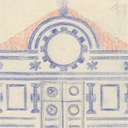0011 Rondocubism versus National Style
Identifiers (Article)
Identifiers (Files)
Abstract
There is a range of various terms used to refer to architectural production from the period after the First World War, among the most common being 'Rondocubism' and the 'National Style'. The terminological ambiguity clearly points to the problem with the very character of the style of expression that lies behind these diverse labels. In the 1920s, figures of the interwar avant-garde were already sharply critical of the post-war decorative style, the leading figures of which were the architects Pavel Janák and Josef Gočár. While this negative stigma was later overcome, following several thematic studies, it is still possible to look for other inspiring sources outside aesthetic categories that were directed at clarifying this theme. Extensive social projects had architects employed in all sorts of artistic activities, and therefore a possible answer to what the essence of the style was is offered by the wider political and cultural context. After the foundation of the Czechoslovak Republic, the former protagonists of architectural Cubism and their colleagues from the Czechoslovak Workshop Association, Artěl and the School of Decorative Arts attained such social standing that they could effectively influence local artistic development. Through the individual conception applied to official commissions they created a visual identity of the new state system. As is apparent from their theoretical writings, they found their sources of information for ornamental decoration of buildings and craft artefacts by bonding with local tradition. This did not of course mean directly borrowing from folk-art prototypes. Advanced forms of national art were intended to help establish Czechoslovakia in the international scene and were also a conscious attempt through a more folkish form of expression to appeal to the wider strata of the population.
Statistics


License

This work is licensed under a Creative Commons Attribution-NonCommercial-NoDerivatives 4.0 International License.



